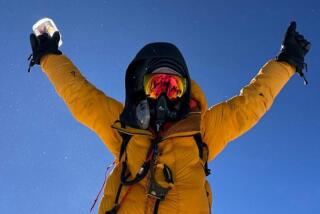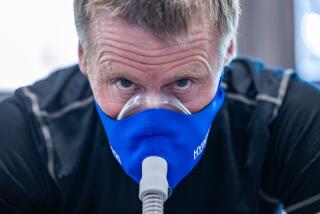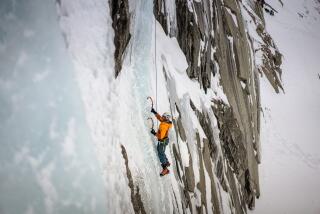Chance for U.S. Woman to Reach the Top
- Share via
Of the more than 150 people who have scaled Everest, only six have been women. None has been an American. I cannot deny I would like to be the first U.S. woman to stand on the summit of the world’s highest mountain, but that ambition does not cloud my responsibilities to the main purpose of this expedition--to search for Mallory and Irvine. Nor does it dampen my hopes that, should I fail, one of the other two women mountaineers on the expedition will succeed.
This is my third trip to Everest. On my first climb, the expedition was turned away from the summit by a series of avalanches. On my second trip, I was not part of the select team that eventually made the summit via the technically difficult east face. But those climbs helped build experience, added to my knowledge of the mountain and boosted my confidence. Above all, they fueled my desire to get to the top.
The first woman to reach Everest’s summit was Junko Tabei, a Japanese climber. Since her ascent in 1975, five other women have made it to the top of the world. They came from Tibet, Poland, Germany, Canada and India. Twenty-five others have tried. Until 1986, no North American woman had scaled Everest. But this spring, Canadian Sharon Wood broke that spell.
A Long-Term Contribution
The point to be made here is that women from all over the world have been quietly, but significantly, contributing to high-altitude mountaineering for quite a while.
I have climbed mountains in the Soviet Union, Peru, France and Nepal, and have made five expeditions to the Himalayas. And the more I climb, the more I understand that expedition climbing has much in common with such sports as professional bicycle racing, where the “winner” owes his or her success to the efforts of an unselfish, closely integrated team. Without the help of teammates and support crews, a potential race winner would be simply another rider unable to break out of the pack. So it is in reaching a mountain summit as part of an expedition.
For this reason, although I have admitted I would prize being the first American woman to scale Everest, it would also give me great joy should that honor go to one of the other two women climbers on this team.
Central Part of Friendship
Mary Kay Brewster has been a friend of mine for several years. We met as climbers in the Rockies, and climbing has remained a central part of our friendship. Mary Kay has never been on Everest before but is an accomplished mountaineer. Her highest climb was to the summit of 19,000-foot Orizaba peak in Mexico.
The other woman who will climb Everest is Catherine Cullinane, a mountaineering guide and instructor in Wyoming’s Grand Teton National Park. She is a highly skilled rock climber with eight years of experience.
As for myself, I quit graduate studies in analytic chemistry at MIT in 1972 and have been climbing ever since. I’ve worked in climbing supply stores, taught Nordic skiing and worked as a computer programmer. But all of these jobs have had the same purpose: to buy free time for climbing.
More to Read
Sign up for The Wild
We’ll help you find the best places to hike, bike and run, as well as the perfect silent spots for meditation and yoga.
You may occasionally receive promotional content from the Los Angeles Times.






